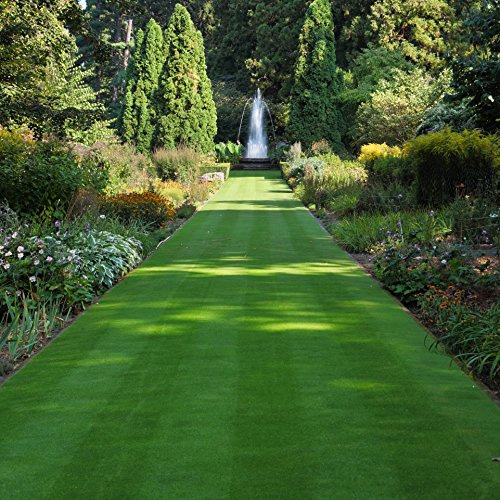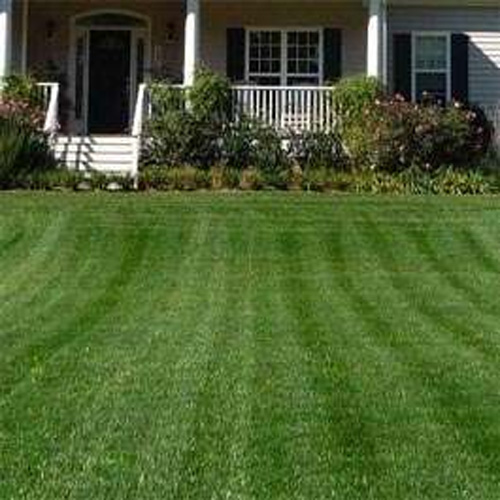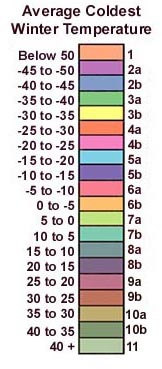
Legacy Fine Fescue
- Close-Mowing
- Lawns
- Resilient

Grasses used in Ohio generally consist of only a few species of grass. The recommended species include: Kentucky bluegrass, perennial ryegrass, tall fescue and fine fescue.
Kentucky Bluegrass
Kentucky bluegrass is the primary lawn turfgrass grown in Ohio. With proper management, Kentucky bluegrass forms a fine-textured, high-quality, long-lasting turf. This species produces rhizomes (underground stems) that give rise to new bluegrass plants. This ability enables bluegrass to rapidly recuperate from injury and fill in thin areas in the lawn. Kentucky bluegrass is winter-hardy and capable of withstanding temperature and moisture extremes. During hot, dry periods it tends to become dormant and lose color. If high quality is desired during the summer period, lawn irrigation is often necessary.
Kentucky bluegrass requires moist, well-drained soil to develop into high-quality turfgrass. It will not tolerate extremely acid or alkaline soils or heavy shade. Germination and establishment rates are slow, and weeds may develop if seeded in late spring or early summer. Kentucky bluegrass requires a medium to high level of management with routine applications of fertilizer. All varieties respond well to a mowing height of 2-2 1/2". Although Kentucky bluegrass performs best in full sun, some cultivars are adapted to shade. For moderate to heavy shade, seed a mixture of Kentucky bluegrasses and fine fescues. The improved cultivars of Kentucky bluegrass have resistance to leaf spot, melting out and other turfgrass diseases. For best results, seed blends of 2-4 cultivars. Because of its durability and exceptional appearance, Kentucky bluegrass is often used in establishing athletic fields.
Perennial Ryegrass
Perennial ryegrass, like Kentucky bluegrass, is a fine-textured species with the potential to develop into a high quality lawn. Perennial ryegrass has rapid seed germination and seedling establishment qualities. This species has a bunch-type growth habit, which enables it to form density through tillering. The cold tolerance and disease resistance capabilities are less than for Kentucky bluegrass but are acceptable for most areas of Ohio. All perennial ryegrasses require well-drained soils of medium to high fertility. The maintenance, fertility and pH requirements are similar to the improved Kentucky bluegrasses. Perennial ryegrass has better drought tolerance than Kentucky bluegrass but normally requires irrigation to maintain quality during most Ohio summers. The optimal mowing height is 2-2 1/2" inches.
In recent years many improved perennial ryegrasses have been commercialized. These improved cultivars have greater cold tolerance, better density, darker color and better disease resistance than the older, common ryegrass selections. These new releases also have substantially better mowing qualities than the common types.
Tall Fescue - Turf Type
Tall fescue has been used traditionally as a low-maintenance grass in areas where a coarser texture is not objectionable. This species is coarser textured than the other recommended turfgrass species. Tall fescue tolerates soils of low fertility, persists well under low maintenance and possesses good tolerance to insects and diseases. This species germinates and establishes quickly but slightly slower than perennial ryegrass. When mature, tall fescue has excellent wear tolerance and, due to its deep-rooted nature, tolerates drought and will remain green throughout most Ohio summers without supplemental irrigation. Juvenile tall fescue seedlings are not cold-tolerant and will be prone to winterkill. However, well-established seedlings and mature lawns will endure most Ohio winters.
Recently, a number of improved "turf-type" tall fescue cultivars have been commercialized. These improved tall fescues are finer textured than the old "Kentucky-31" cultivar. These improved cultivars are less coarse, grow more upright, tiller more readily and exhibit a darker green color. All tall fescues grow rapidly in the spring and require more frequent mowing than Kentucky bluegrass. The popularity of the improved turf-type tall fescues is increasing and they are now being used on many lawn sites, playgrounds, parks and low-maintenance athletic fields where the use of coarser textured grasses is not objectionable.
Fine Fescue
Red, hard and chewings fescues are fine-leaved turfgrasses that grow well under conditions of shade, low soil moisture, low fertility, and soils with unfavorable pHs. The fine fescues require well-drained slightly dry soils with minimum levels of management. Excess applications of fertilizer, frequent irrigation or establishment on poorly drained soils will result in a decline in quality and plant density.
With correct management, the fine fescues can make an attractive turf of fair to good quality. In Ohio, the fine fescues are seldom seeded alone, or intended to be the principle species where other cool-season grasses can be cultured. Fine fescues are commonly used in mixtures with the other cool-season turfgrasses on low maintenance or shady lawns.
| Click Name To View Grass Seed Choice | Type | Applications | |
|---|---|---|---|
| Cool Season Mix - Showtime |
|
Cool Season |
Lawns - Full Sun to Moderate Shade Rye, Kentucky Bluegrass, Fine Fescue Mix |
| Cool Season Mix - Garland |
|
Cool Season |
Lawns - Full Sun to Moderate Shade Rye, Fine Fescue Mix |
| Fescue/Bluegrass Mix - Combat Extreme North |
|
Cool Season | Lawns - Wear Tolerant |
| Fescue Blend - Combat Extreme Transition |
|
Cool Season | Lawns - Wear Tolerant |
| Fine Fescue Blend - Legacy |
|
Cool Season | Lawns - Full Sun To Moderate Shade |
| Kentucky Bluegrass - Bluegrass Supreme |
|
Cool Season | Lawns - Golf Gourses - Full Sun |
| Kentucky Bluegrass - Midnight |
|
Cool Season | Lawns - Golf Courses - Full Sun |
| OSP Ryegrass |
|
Cool Season | Lawns - Golf Courses |
| Shade Grass - Poa Supina Mix |
|
Cool Season | Lawns - Full Sun - Deep Shade - Best Shade Grass |


Below is the USDA Zone Map for Ohio so you can determine which zone you reside in. Below that are our picks for your state which will do best in your area. Next on this page are tables which list various grasses and their characteristics so you can compare before you decide on your purchase. Click on the product name (ie. Midnight) for more information about that grass and to make your purchase.
| USDA Zone Map For Ohio | |
|---|---|
 |
 |
| Compare Various Grasses For Their Characteristics | ||||||||
|---|---|---|---|---|---|---|---|---|
| Cool Season Grasses |
Leaf Texture |
Establish Rate |
Nitrogen Use |
Water Use |
Drought Tolerance |
Salinity Tolerance |
Shade Tolerance |
|
| Bluegrass - Kentucky | Moderate to Fine |
Slow | Moderate to High |
Moderate to High |
Good | Moderate | Poor | |
| Bluegrass - Rough | Moderate to Fine |
Slow | Moderate to High |
Moderate to High |
Poor | Moderate | Excellent | |
| Fescue - Hard | Fine | Slow to Moderate |
Low to Very Low |
Moderate | Excellent | Low to Moderate |
Excellent | |
| Fescue - Creeping | Fine | Moderate | Low to Moderate |
Moderate | Good | Low | Excellent | |
| Fescue - Turf Type | Moderate to Coarse |
Moderate | Moderate to High |
Low to Moderate |
Excellent | Low | Good to Excellent |
|
| Ryegrass - Perennial | Fine to Moderate |
Very Fast | Moderate to High |
Moderate to High |
Good | Poor to Moderate |
Poor to Moderate |
|
| Warm Season Grasses |
Leaf Texture |
Establish Rate |
Nitrogen Use |
Water Use |
Drought Tolerance |
Salinity Tolerance |
Shade Tolerance |
|
| Blue Grama | Fine to Moderate |
Slow to Moderate |
Low | Low | Excellent | Moderate | Very Poor | |
| Buffalograss | Moderate to Coarse |
Slow to Moderate |
Low | Low | Excellent | Moderate | Very Poor | |
| Compare Various Grasses For Their Characteristics - Continued | ||||||||
|---|---|---|---|---|---|---|---|---|
| Cool Season Grasses |
Fertility Needs |
Wear Resistance |
Mowing Height |
Cold Tolerance |
Acid Soil Tolerance |
Thatching Tendency |
Heat Tolerance |
|
| Bluegrass - Kentucky | Medium | Medium to High |
Medium | High | Medium | Medium | Medium | |
| Bluegrass - Rough | Medium | Medium | Medium | High | Medium | Medium | Medium | |
| Fescue - Hard | Low | Low | Medium | Medium to High |
Medium to High |
Low to Medium |
Low to Medium |
|
| Fescue - Turf Type | Low to Medium |
Medium to High |
Medium to High |
Medium | High | Low | High | |
| Ryegrass - Perennial | Medium | High | Low to Medium |
Medium | Medium | Low | Medium to High |
|
| Warm Season Grasses |
Fertility Needs |
Wear Resistance |
Mowing Height |
Cold Tolerance |
Acid Soil Tolerance |
Thatching Tendency |
Heat Tolerance |
|
| Blue Grama | Low | Low | High | High | Low | Low | High | |
| Buffalograss | Low | Low | High | High | Low | Low | High | |